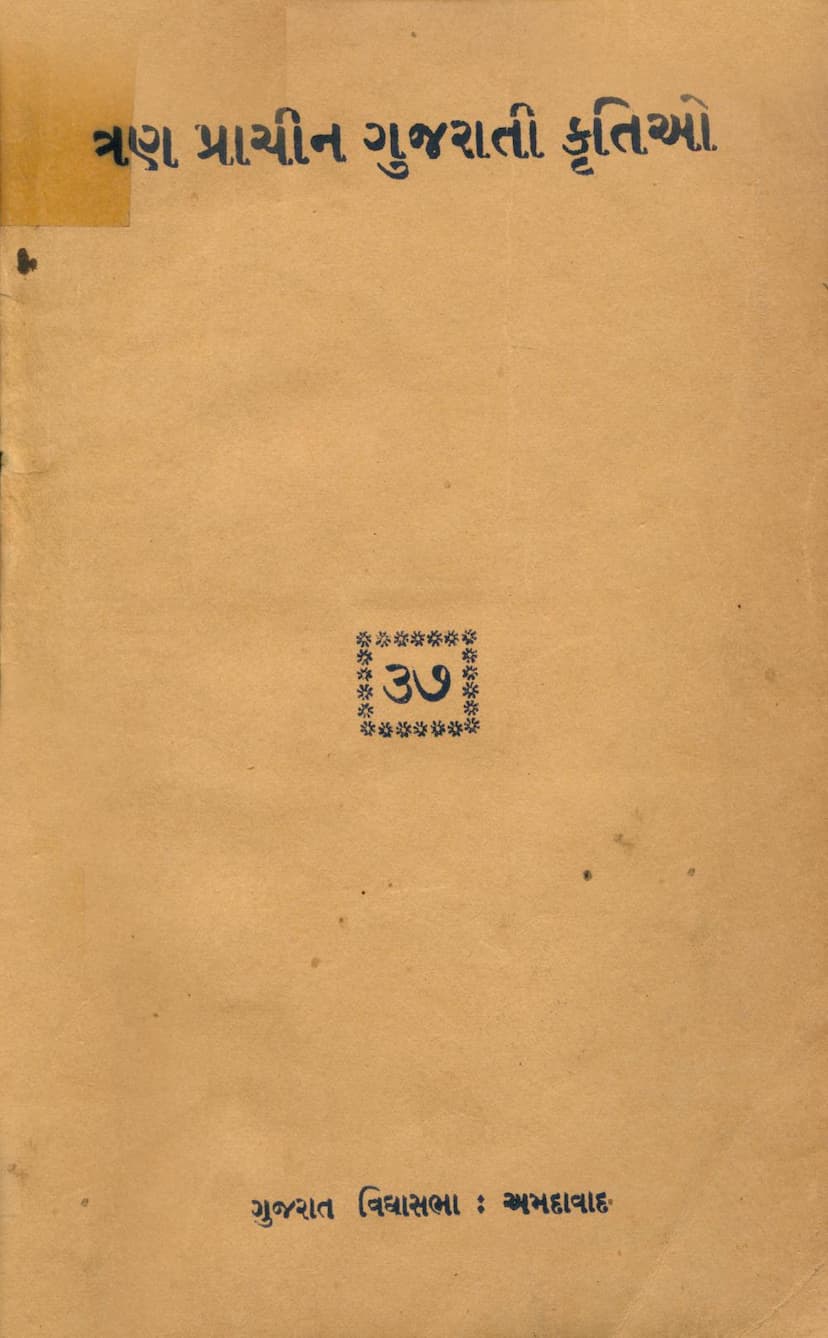Tran Prachin Gujarati Krutio
Added to library: September 2, 2025

Summary
Here's a comprehensive summary of the Jain text "Tran Prachin Gujarati Krutio" (Three Ancient Gujarati Works), based on the provided pages:
Book Title: Tran Prachin Gujarati Krutio (ત્રણ પ્રાચીન ગુજરાતી કૃતિઓ) Author(s): Compiled by Dr. Charlotte Crouse (also known as Shrimati Subhadra Devi) Publisher: Gujarat Vidyasabha, Ahmedabad Publication Year: V.S. 2007 (1951 CE)
Overview: This book, published by Gujarat Vidyasabha, is a collection and critical edition of three ancient Gujarati literary works, primarily related to Jain literature and history. The compilation and scholarly endeavor were undertaken by Dr. Charlotte Crouse, a German scholar of Indian literature and culture, who is also known as Shrimati Subhadra Devi. The publication is part of the "Sadhan Granthamala" series.
Key Contents and Their Significance:
-
Shri Shankheshwar Parshvanath Chhand (શ્રી શંખેશ્વર પાર્શ્વનાથ છંદ) by Nay Sundar:
- This is a significant work by the renowned poet Nay Sundar, a disciple of Bhanumeru Ganini.
- The work praises Lord Parshvanath and his glorious deeds, especially focusing on the pilgrimage sites and idols (bibs) related to him.
- It is important for its contribution to the history of Jain literature, linguistics, and for providing information about ancient Parshvanath temples and their deities.
- The introduction highlights Nay Sundar's lineage and his connection to important Jain monastic traditions (Gachh).
- The poem itself is structured in various meters (Chhandas) and includes Sanskrit verses at the beginning and Gujarati verses throughout.
- The text is rich in its use of ancient Gujarati vocabulary, grammatical forms, and linguistic features, which are valuable for linguistic study.
- It describes 108 names of Lord Parshvanath and discusses the importance of mantras.
- The summary of the poem details its praise of Lord Parshvanath, descriptions of pilgrimage sites, accounts of overcoming dangers through devotion, and elements of Hatha Yoga philosophy within the narrative of Lord Parshvanath's life.
-
Tran So Panshath Parshva-nam-mala (ત્રણસો પાંસઠ પાર્શ્વ-નામ-માળા) by Prem Vijay:
- This work by Prem Vijay, a disciple of Vimal Harsh Vachak, lists "three hundred and sixty-five names of Parshvanath" (or possibly relating to pilgrimage sites).
- The work is significant for its catalog of Parshvanath idols and places, offering valuable data for historians of Jain temples and sites.
- It is noted that this work was previously unpublished and less known.
- The author, Prem Vijay, is known for other works as well.
- The primary importance of this work lies in its detailed listing of places and associated idols, contributing to the Jain topographical and iconographical history.
-
Vriddha Chaitya-vandan (વૃદ્ધ ચૈત્ય-વંદન) by Khema:
- This work is attributed to the poet Khema, who is mentioned in the writings of Rishabhdas.
- The text is a devotional hymn or eulogy intended for circumambulation of ancient chaityas (temples).
- It is significant for its mention of the poet Khema and its contribution to the devotional literature of Jainism.
- The text lists various Tirthankaras and important pilgrimage sites, indicating a devotional and historical survey of Jain holy places.
- The author's time period is estimated to be between V.S. 1378 and V.S. 1619.
- This work is considered valuable for its devotional sentiment and its connection to the lineage of Jain poets.
Editorial Work and Dr. Charlotte Crouse's Contribution: The preface (Aamukh) and introduction (Prastavana) strongly emphasize Dr. Charlotte Crouse's (Shrimati Subhadra Devi's) dedication and scholarship. It highlights her deep immersion in Jain Agamas, philosophy, languages (Gujarati, Hindi), and culture, despite being from Germany. Her role as Deputy Inspector General in the Education Department of Gwalior State is also mentioned, indicating her administrative and societal contributions. The foreword praises her meticulous editing, which includes providing critical notes, variant readings, lists of places and deities, and bibliographical information, greatly enhancing the usability of the ancient texts for scholars and enthusiasts. The editor's ideal of carefully editing one work rather than publishing many in poor condition is lauded.
Historical and Linguistic Significance: The book is noted for preserving and presenting ancient Gujarati literature, which is crucial for understanding the evolution of the language and its literary traditions. The linguistic analysis within the commentary section points out the mixed nature of the language, influenced by various regional dialects and perhaps artistic choices of the poets, which is common in medieval Gujarati literature, especially among Jain monks who traveled extensively. The text provides valuable insights into the religious practices, historical geography, and the socio-cultural milieu of the periods these works were composed.
Overall Purpose: The "Tran Prachin Gujarati Krutio" serves to bring to light and make accessible important, yet previously obscure or unpublished, ancient Jain literary and historical documents. It aims to aid researchers in Gujarati literature, Jain studies, and Indian history, contributing to a deeper understanding of the rich heritage preserved within the Jain tradition. The meticulous editing and scholarly annotations by Dr. Crouse are central to the book's value.